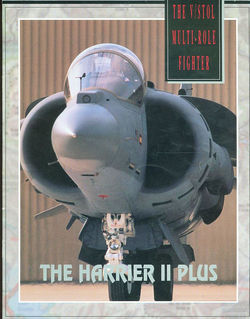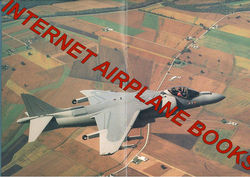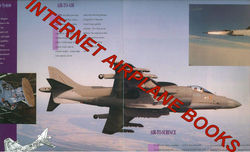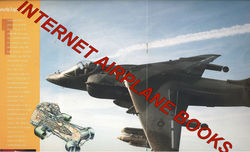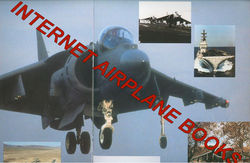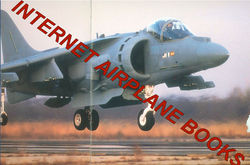HARRIER II PLUS RAF_USMC VMA_RR
PEGASUS_HUGHES APG-65_HUD_FLIR_AAM_ASM_SPAIN_ITALY_V/STOL_DESERT STORM
THE V/STOL MULTI-ROLE FIGHTER
IN SERVICE AROUND THE WORLD (BRITISH ROYAL AIR FORCE RAF,
UNITED STATES MARINE CORPS USMC VMA, ITALIAN NAVY, SPANISH NAVY)
SOLUTIONS TO TOMORROW’S CHALLENGES
HUGHES APG-65 RADAR
AIR-TO-AIR WEAPONS CAPABILITIES
AIR-TO-SURFACE WEAPONS CAPABILITIES
NIGHT ATTACK (HUD, FLIR)
ROLLS-ROYCE PEGASUS 11-41 (F402-RR-408) JET ENGINE
AERODYNAMIC FEATURES
FIRST-PASS ACCURACY
FLEXIBLE BASING OPTIONS
AUTONOMOUS OPERATIONS
SURVIVABILITY
COMBAT PROVEN IN OPERATION DESERT STORM
AIRCREW / MAINTENANCE TRAINING
SUPPORT PROGRAMS
OPERATIONAL ADVANTAGES
-----------------------------------------------------------------------------------------
Most of the first "day attack" AV-8B Harrier
IIs were upgraded to Night Attack Harrier or Harrier II Plus standards, with
the remainder being withdrawn from service. The AV-8B cockpit was also used for
the early trialing of Direct Voice Input (DVI), which allows the pilot to use
voice commands to issue instructions to the aircraft, using a system developed
by Smiths Industries. The main attack avionics system in original aircraft was
the nose-mounted Hughes AN/ASB-19 angle-rate bombing system. The system
combined a TV imager and laser tracker to provide a highly accurate targeting
capability. Defensive equipment include several AN/ALE-39 chaff-flare
dispensers, an AN/ALR-67 radar warning receiver, and an AN/ALQ-126C jammer pod.
The trainer version of the AV-8B is the TAV-8B, seating
two pilots in tandem. Among other changes, the forward fuselage features a 3 ft
11 in (1.19 m) extension to accommodate the second cockpit. To compensate for
the slight loss of directional stability, the vertical stabilizer's area was
enlarged through increases in chord (length of the stabilizer's root) and
height. USMC TAV-8Bs feature the AV-8B's digital cockpit and new systems, but
have only two hardpoints and are not combat capable.[36] Initial TAV-8Bs were
powered by a 21,450 lbf (95.4 kN) F402-RR-406A engine, while later examples
were fitted with the 23,000 lbf (105.8 kN) F402-RR-408A. In the early 2000s, 17
TAV-8Bs were upgraded to include a night-attack capability, the F402-RR-408
engine, and software and structural changes.
Fielded in 1991, the Night Attack Harrier was the first
upgrade of the AV-8B. It differed from the original aircraft in having a
forward looking infrared (FLIR) camera added to the top of the nose cone, a
wide Smiths Industries head-up display (HUD), provisions for night vision
goggles, and a Honeywell digital moving map system. The FLIR uses thermal
imaging to identify objects by their heat signatures. The variant was powered
by the F402-RR-408 engine, which featured an electronic control system and was
more powerful and reliable. The flare and chaff dispensers were moved, and the
ram air intake was lengthened at the fin's base. Initially known as the AV-8D,
the night-attack variant was designated the AV-8B(NA).
The Harrier II Plus is very similar to the Night Attack
variant, with the addition of an APG-65 multi-mode pulse-Doppler radar in an
extended nose, allowing it to launch advanced beyond-visual-range missiles such
as the AIM-120 AMRAAM. To make additional space for the radar, the angle-rate
bombing system was removed. The radars used were taken from early F/A-18
aircraft, which had been upgraded with the related APG-73. In addition to the
AIM-120, the AV-8B Plus can also carry AGM-65 Maverick and AGM-84 Harpoon
missiles. According to aviation author Lon Nordeen, the changes "had a
slight increase in drag and a bit of additional weight, but there really was
not much difference in performance between the [–408-powered] Night Attack and
radar Harrier II Plus aircraft".
In 1999, the AV-8B participated in NATO's bombing of
Yugoslavia during Operation Allied Force. Twelve Harriers were split evenly
between the 24th and 26th Marine Expeditionary Units (MEU). AV-8Bs of the 24th
MEU were introduced into combat on 14 April, and over the next 14 days flew 34
combat air support missions over Kosovo. During their six-month deployment aboard
USS Nassau, 24th MEU Harriers averaged a high mission-capable rate of 91.8
percent. On 28 April, the 24th MEU was relieved by the 26th MEU, based on USS
Kearsarge. The first combat sorties of the unit's AV-8Bs occurred two days
later, one aircraft being lost. The 26th MEU remained in the theater of
operations until 28 May, when it was relocated to Brindisi, Italy.
USMC AV-8Bs took part in Operation Enduring Freedom in
Afghanistan from 2001. The USMC 15th MEU arrived off the coast of Pakistan in
October 2001. Operating from the unit's ships, four AV-8Bs began attack
missions into Afghanistan on 3 November 2001. The 26th MEU and its AV-8Bs
joined 15th MEU later that month. In December 2001, two AV-8Bs first deployed
to a forward base at Kandahar in Afghanistan. More AV-8Bs were deployed with
other USMC units to the region in 2002. The VMA-513 squadron deployed six Night
Attack AV-8Bs to Bagram in October 2002. These aircraft each carried a LITENING
targeting pod to perform reconnaissance missions along with attack and other
missions, primarily at night.
The aircraft participated in the Iraq War in 2003, acting
primarily in support of USMC ground units. During the initial action, 60 AV-8Bs
were deployed on ships such as USS Bonhomme Richard and Bataan, from which over
1,000 sorties were flown throughout the war. When possible, land-based forward
arming and refuelling points were set up to enable prompt operations. USMC
commander Lieutenant General Earl B. Hailston said that the Harriers were able
to provide 24-hour support for ground forces, and noted that "The airplane
... became the envy of pilots even from my background ... there's an awful lot
of things on the Harrier that I've found the Hornet pilots asking me [for] ...
We couldn't have asked for a better record".
USMC sources documented the Harrier as holding an 85
percent aircraft availability record in the Iraq War; in just under a month of
combat, the aircraft flew over 2,000 sorties. When used, the LITENING II
targeting pod achieved greater than 75 percent kill effectiveness on targets.
In a single sortie from USS Bonhomme Richard, a wave of Harriers inflicted
heavy damage on a Republican Guard tank battalion in advance of a major ground
assault on Al Kut. Harriers regularly operated in close support roles for
friendly tanks, one of the aircraft generally carrying a LITENING pod. Despite
the Harrier's high marks, the limited amount of time that each aircraft could
remain on station, around 15–20 minutes, led to some calls from within the USMC
for the procurement of AC-130 gunships, which could loiter for six hours and
had a heavier close air support capability than the AV-8B. AV-8Bs were later
used in combination with artillery to provide constant fire support for ground
forces during heavy fighting in 2004 around the insurgent stronghold of
Fallujah. The urban environment there required extreme precision for
airstrikes.
On 20 March 2011, USMC AV-8Bs were launched from USS
Kearsarge in support of Operation Odyssey Dawn, enforcing the UN no-fly zone
over Libya. They carried out airstrikes on Sirte on 5 April 2011. Multiple
AV-8Bs were involved in the defense of a downed F-15E pilot, attacking
approaching Libyans prior to the pilot's extraction by a MV-22 Osprey.
In addition to major conflicts, USMC AV-8Bs have been
deployed in support of contingency and humanitarian operations, providing
fixed-wing air cover and armed reconnaissance. The aircraft served in Somalia
throughout the 1990s, Liberia (1990, 1996, and 2003), Rwanda (1994), Central
African Republic (1996), Albania (1997), Zaire (1997), and Sierra Leone (1997).
In 1999, Italian AV-8Bs were used for the first time in
combat missions when they were deployed aboard Giuseppe Garibaldi, which was
participating in Operation Allied Force in Kosovo. Italian pilots conducted
more than 60 sorties alongside other NATO aircraft, attacking the Yugoslav army
and paramilitary forces and bombing the country's infrastructure with conventional
and laser-guided bombs (LGB).
In 2000, the Italian Navy was looking to acquire a
further seven remanufactured aircraft to equip Giuseppe Garibaldi and a new
carrier, Cavour. Existing aircraft, meanwhile, were updated to allow them to
carry AIM-120 AMRAAMs and JDAM guided bombs.[59][131] From November 2001 to
March 2002, eight AV-8Bs were embarked aboard Giuseppe Garibaldi and were
deployed to the Indian Ocean in support of Operation Enduring Freedom. The
aircraft, equipped with LGBs, operated throughout January and February 2002,
during which 131 missions were logged for a total of 647 flight hours.
In 2011, Italian Harriers, operating from Giuseppe
Garibaldi, worked alongside Italian Eurofighters and aircraft of other nations
during Operation Unified Protector, part of the 2011 military intervention in
Libya. They conducted airstrikes as well as intelligence and reconnaissance
sorties over Libya, using the LITENING targeting pods while armed with AIM-120
AMRAAMs and AIM-9 Sidewinders. In total, Italian military aircraft delivered
710 guided bombs and missiles during sorties: Italian Air Force Tornados and
AMX fighter bombers delivered 550 bombs and missiles, while the eight Italian
Navy AV-8Bs flying from Giuseppe Garibaldi dropped 160 guided bombs during
1,221 flight hours.
n March 1993, under the September 1990 Tripartite MoU
between the U.S., Italy, and Spain, eight EAV-8B Plus Matadors were ordered,
along with a twin-seat TAV-8B. Deliveries of the Plus-standard aircraft started
in 1996. On 11 May 2000, Boeing and the NAVAIR finalized a contract to
remanufacture Spanish EAV-8Bs to bring them up to Plus standard. Boeing said
the deal required it to remanufacture two EAV-8Bs, with an option for another
seven aircraft; other sources say the total was 11 aircraft. The remanufacture
allowed the aircraft to carry four AIM-120 AMRAAMs, enhanced the pilot's
situational awareness through the installation of new radar and avionics, and
provided a new engine. Eventually, five aircraft were modified, the last having
been delivered on 5 December 2003.
Spanish EAV-8Bs joined Operation Deny Flight, enforcing
the UN's no-fly zone over Bosnia and Herzegovina. Spain did not send its
aircraft carrier to participate in the Iraq War in 2003, instead deploying
F/A-18s and other aircraft to Turkey to defend that country against potential
Iraqi attacks. Starting in 2007, Spain was looking to replace its Harrier
IIs–with the likely option being the F-35B. The Spanish government, in May 2014
however, announced that it had decided to extend the aircraft's service life to
beyond 2025 due to a lack of funds for a replacement aircraft.
Following the decommissioning of Príncipe de Asturias in
February 2013, the sole naval platform from which Spanish Harrier IIs can
operate is the amphibious assault ship Juan Carlos I.



